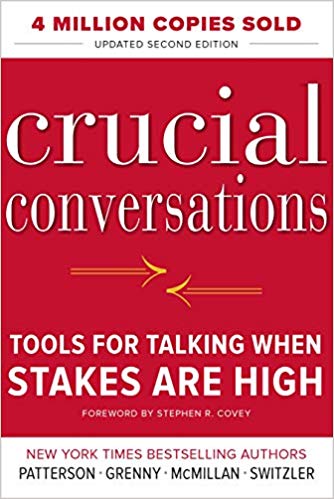

This article is an excerpt from the Shortform summary of "Crucial Conversations" by Kerry Patterson. Shortform has the world's best summaries of books you should be reading.
Like this article? Sign up for a free trial here .
Do you want to know how to listen better in order to improve your communication skills? Is learning how to listen a roadblock to having important crucial conversations?
Learning how to listen is one of the most important, and often overlooked, parts of building good communication skills. Using the tools in Crucial Conversations, you can learn how to listen to someone in a difficult conversation, and take steps to fix the problem.
How to Listen: Steps to Connecting
Learning how to listen better is one of the most important parts of developing better communication skills. These tips can help you learn how to listen to someone and get the most out of the conversation.
1. Use AMPP
To encourage others to share, use four listening tools: Ask, mirror, paraphrase, prime (AMPP). These tools will help you learn how to listen to someone, and how to listen well.
A: Ask
Ask to get things going: Often all it takes to break an impasse is to seek to understand others’ views. When you show genuine interest, people feel less compelled to use silence/violence. For example, use phrases like, “What do you mean? I’d like to hear your concerns.” Other invitations include: “What’s going on?” “Please let me know if you see it differently.” “Don’t worry about hurting my feelings; I really want to hear your thoughts.”
M: Mirror
Mirror to confirm feelings: Mirroring can help build more safety. It consists of playing the role of mirror by describing to the person how they look or act. We see their actions and reflect them back.
Mirroring is most useful when the other person’s tone/gestures are inconsistent with their words.
For example, they may say, “Don’t worry, I’m fine,” when clearly they’re not fine. A mirroring response would be, “Really? It doesn’t sound like you are.” Explain that while the person may be saying one thing, his body language or tone belies it. For instance, “You look nervous about signing the contract. Are you sure you’re OK with buying this car?”
With your tone, convey that you’re OK with them feeling the way they’re feeling; respond calmly rather than being upset.
P: Paraphrase
Paraphrase to acknowledge the story: When you get a clue for why the person is feeling the way they do, you can build additional safety by paraphrasing what you heard. Don’t just parrot back what they say, but put the message in your own words in abbreviated form. For instance, “Let’s see if I’ve got this right. You’re upset because…”
Don’t react negatively. Stay focused on figuring out how a reasonable person could have concluded this. Rephrase in a way that suggests it’s OK to speak, that you’re trying to understand.
P: Prime
Prime when you’re still stalled: When you believe another person still has something to share and might do so with further encouragement, you can try priming the conversation. Offer a guess at what the other person is thinking or feeling, and she may respond. For example, “Are you thinking that the only reason we’re doing this is to make money?”
2. Don’t Push Too Hard
Knowing how to listen well also means knowing when to back off. When you can tell the other person has more to share, but isn’t sharing it, you may want to back off. Repeated attempts to encourage sharing can feel like pushing. So end the conversation tactfully, or ask what they want to see happen. This question helps them move toward problem solving (away from silence/violence).
3. When You Disagree
Of course, disagreements are inevitable sometimes. Exploring another’s path (facts, story, feelings) when you disagree substantially can be unsettling. This is where knowing how to listen well comes in.
However, you’re trying to understand their point of view, not necessarily agree with or support it. By making an effort to understand it, you’re agreeing to accept it as part of the pool of information; later you can share your point of view too.
So you explore what others think in order to understand why they’re feeling and behaving as they are.
4. Remember the ABC’s
When it’s your turn to talk, and your story differs a lot from what you just heard, use these three skills. Knowing how to listen also means knowing how to communicate back to them what you feel.
Agree: Don’t argue when you agree — just agree. Sometimes when people argue strenuously, they’re arguing over nuances. They actually agree on the important points. Most arguments are about the 5% to 10% of the facts and stories that people disagree on.
Although people eventually need to work through all their differences, you shouldn’t start with the nuances, but with an area of agreement. If you completely agree with the other person’s path, say so and move on.
Build: Look for points of agreement, and talk about those first. Then build by adding information that has been left out. (“I agree completely. In addition, I noticed that…”)
Instead of building on what we agree on, we tend to immediately jump on small points of disagreement, which we magnify. We learn from an early age to look for minor errors. In school, we learn that finding even the smallest errors in others’ facts or thinking wins praise and admiration from teachers and peers. Being right at the expense of others becomes a competition.
Instead of constructive dialogue, you end up in “violent agreement,” or arguing strenuously even though you mostly agree.
Compare: When you do disagree, compare your path with the other person’s. Don’t suggest they’re wrong, suggest that you differ. The person may in fact be wrong, but you can’t be sure until you understand both sides — you just know that you differ.
Instead of starting with “Wrong!”, start with a tentative but honest, “I think I see things differently. Let me explain.” Then share your path using STATE skills. (Share your facts, Tell your story, Ask for others’ paths, Talk tentatively, Encourage testing.)
5. Encourage Others to Rethink Their Path
Others need help to retrace their path to action, but most of us fail to do this. Knowing how to listen better can help you get others to rethink their own perspective.
We typically enter the conversation at the end of their path, when they’re starting to act out their story (with silence or violence). Start where they are and help them work backward to the source — from feelings, to what they concluded, to what they observed.
- Break the cycle: The typical response to nonconstructive behavior is to match it. But you need to stop the cycle by stepping away from the interaction and making it safe for the other person to talk about their path to action. Help them to move away from intense feelings and reactions and return to the cause (the facts and story behind the emotion).
- Ask: When someone is upset, they have a story and facts to share. Be genuine and sincere in inviting them to share, regardless of their emotions. Listen in a way that makes it safe for them to share. They must believe they won’t offend or suffer from speaking honestly.
Remember that learning how to listen means being honest with the parts of yourself that are difficult to address. The skills you’ll learn regarding how to listen well can help make difficult conversations drivers of progress in your relationship.

———End of Preview———
Like what you just read? Read the rest of the world's best summary of Kerry Patterson's "Crucial Conversations" at Shortform .
Here's what you'll find in our full Crucial Conversations summary :
- How to approach an argument without getting mad
- The mistakes most people make when trying to listen to someone else
- How to come up with win-win solutions that make everyone happy






